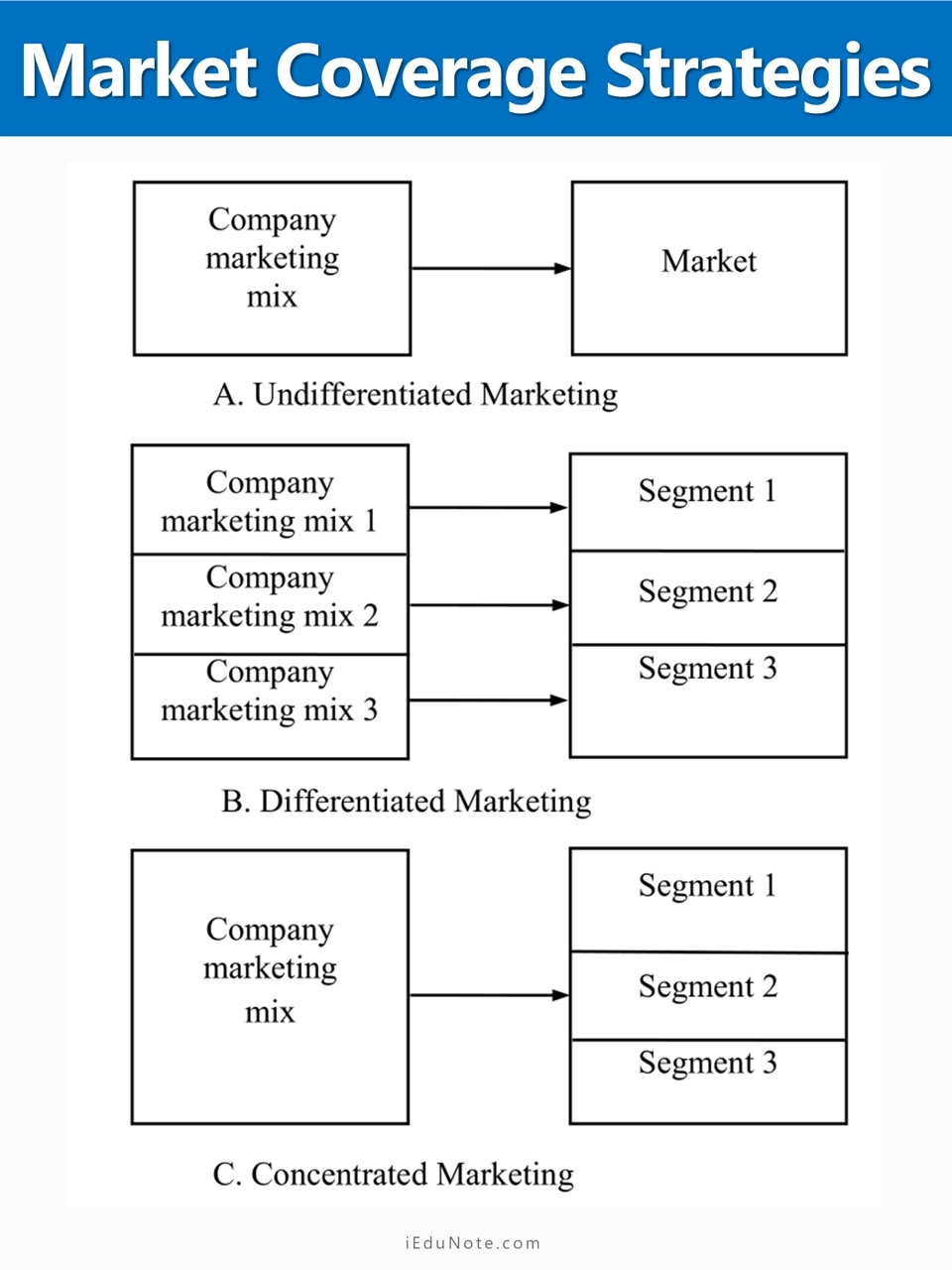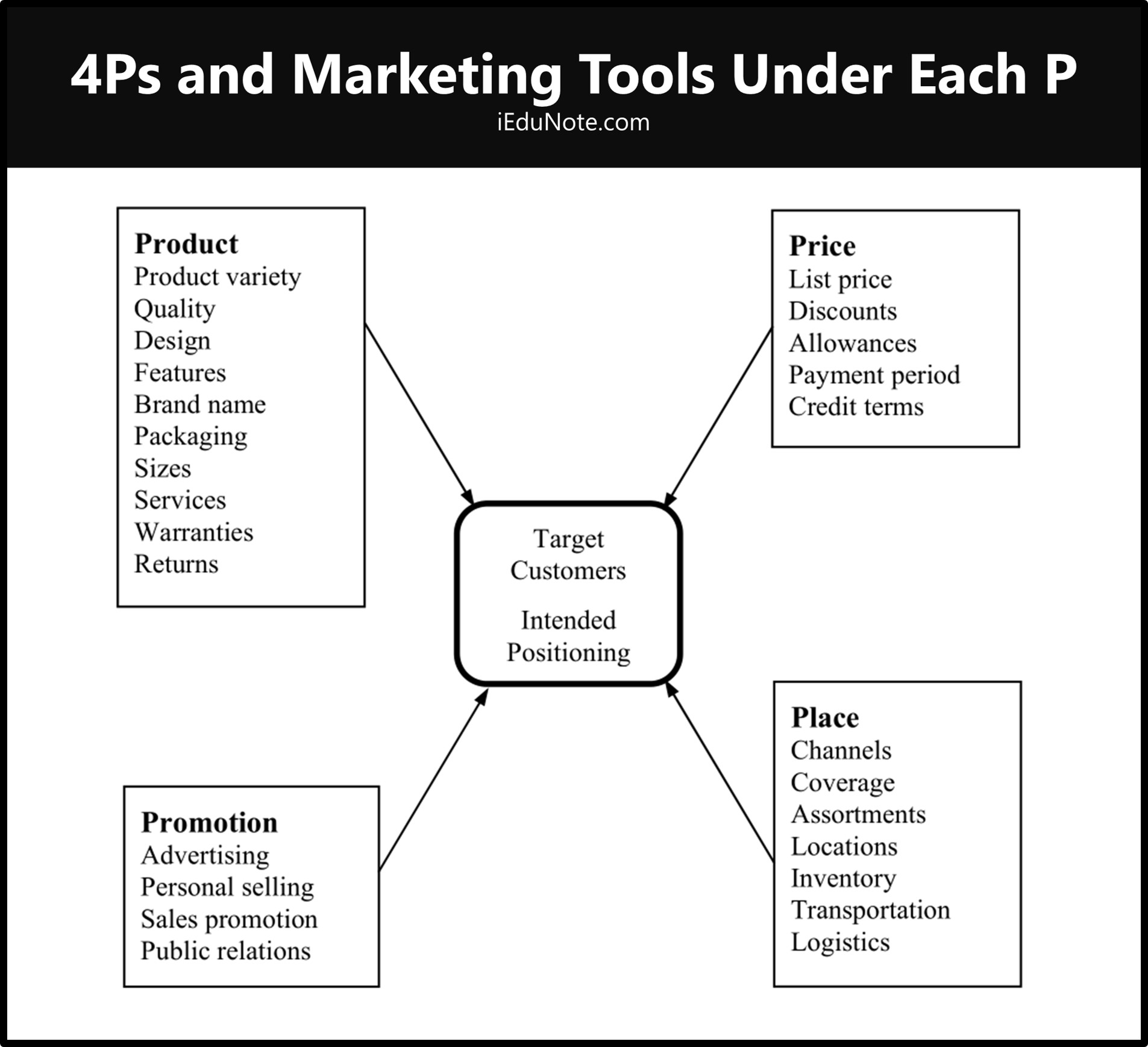Once the market segmentation has been completed, the company should be aware of the needs and wants of its selected segments. It is in the interest of the business to identify any untapped needs in the marketplace, as there could be customers who may not be adequately served by competitors. It is then necessary to identify the most profitable segments and to decide which segments will be served.
3 market coverage alternatives can be applied; (1) undifferentiated marketing, (2) differentiated marketing, and (3) concentrated marketing. Which one should be selected?
Businesses should only consider those market segments that are profitable. Therefore, they should target profitable customers within those segments and nurture a long-lasting relationship with them.

3 market coverage strategies are;
- Undifferentiated Marketing,
- Differentiated Marketing,
- Concentrated Marketing
1. Undifferentiated Marketing
Adopting an undifferentiated marketing strategy, a company does not consider market segment differences and approaches the whole market with one offer. The offer concentrates on what is common in the needs of consumers, ignoring what is different. The company develops a product and a marketing program that appeal to the majority of the buyers.
It depends on mass distribution and mass advertising.
Undifferentiated marketing provides the benefits of cost economies. The limited product line keeps the production, inventory, and transportation costs down. Advertising costs are also low because of the undifferentiated advertising program.
Costs of marketing research and product management are also low because the company is not engaged in conducting market segmentation research and planning.
However, some marketers have reservations about this strategy. Developing a product or brand that will satisfy all consumers is a very difficult task.
In undifferentiated marketing, companies typically develop an offer for the largest segments in the market. When several companies operate in the largest segments using undifferentiated strategy, competition intensifies—simultaneously, fewer satisfaction results in smaller segments.
Ultimately the larger segments may be less profitable because they invite the heavy competition. To avoid this problem, companies become more interested in smaller market segments.
Example of Undifferentiated Marketing:
Here a company develops a product that is suitable for almost the whole market. But the product has some distinct quality (flavor, color, size, support, warranty, and more) that puts the product in a unique place in customers’ minds.
- Toothpaste is the best example. You can use any toothpaste. The whole market uses toothpaste. There are few exceptions where companies produce toothpaste for kids (which requires heavy marketing to sell) or specialized medicinal toothpaste for dental problems (which people only buy if a doctor prescribes them)
- Like toothpaste, there are several other product categories that require undifferentiated marketing. Bottled water, Wheat, Rice, basically anything mass produces and mass-consumed.
2. Differentiated Marketing
Adopting a differentiated marketing strategy, a company targets several market segments and approaches each segment with separate offers.
General Motors tries to produce a car for every “purse, purpose, and personality.” Nike refreshes athletic shoes for a dozen or more different sports, from running, fencing, and aerobics to bicycling and baseball.
And Wal-Mart appeals to the needs of different shopper segments with Wal-Mart discount stores, Wal-Mart supercentres, and Sam’s Warehouse stores.18 By using a differentiated marketing strategy, a company expects to derive certain benefits. It expects that product and marketing variations will fetch higher sales and secure a stronger position within each market segment.
The company thinks that a stronger position in several segments will reinforce consumers’ overall identification with the product category. It also expects that differentiated marketing will enhance loyal purchasing because its offer is more compatible with the segment’s needs.
Although differentiated marketing brings more sales than undifferentiated marketing, and companies are increasingly adopting this strategy, it has certain demerits. Differentiated marketing leads to increasing costs.
Product modification to meet the needs of different market segments calls for additional research and development, engineering, or special tooling costs resulting in an overall increase in costs.
Individualizing marketing plans to the needs of separate segments calls for extra marketing research, forecasting, sales analysis, promotion planning, and channel management – all contributing to an increase in costs.
Different advertising directed towards different market segments increases promotion costs. Therefore, when choosing a differentiated marketing strategy, a company must be sure that increased sales outweighs increased costs.
Example of differentiated marketing
- eCommerce websites giving free delivery to a certain area where the competition can’t
- Celluar service providers are promoting that they have the best mobile data rates, or they have the best 4G/5G network in your area.
- A restaurant is promoting the fact they server special meat platter, or they have separate special offers for students.
3. Concentrated Marketing
Concentrated marketing is especially effective when a company has resource constraints. Instead of choosing a small share of a large market, the company chooses a large share of one or a few submarkets.
For example, Oshkosh Truck is the world’s largest producer of airport rescue trucks and front-loading concrete mixers. Recycled paper products concentrate on the market for alternative greeting cards.
And Soho Natural Sodas concentrates on a narrow segment of the soft-drink market. Small new businesses can place themselves against larger and stronger competitors by using concentrated marketing.
Concentrated marketing offers certain benefits. As the company becomes aware of the segments’ needs and acquires a special reputation, it achieves a strong market position.
Concentrated marketing provides many operating economies resulting from specialization in production, distribution, and promotion. A well-chosen segment served with concentrated marketing ensures a high rate of return on the company’s investment.
Concentrated marketing has a problem of greater than normal risks. The particular market segment might turn to be unprofitable. Stronger competitors may enter the same segment.
California Cooler’s success in the wine cooler segment attracted many large competitors, causing the original owners to sell to a larger company with more marketing resources. To avoid these problems, many companies choose to diversify in several market segments.
Companies with limited resources will usually target just one or a few sub-markets. If a segment is successfully chosen, there is a possibility that the firm may earn a high rate of return on its investment. However, this form of marketing could also involve a high-risk factor. If the selected segment fails, the company can experience hefty losses.
In sum, the appropriate market coverage strategy may be determined by many factors:
- The company’s resources. If the resources are limited, concentrated marketing could be the most logical choice.
- The type of service is to be offered. For example, airlines could offer chartered or scheduled service, low-cost or full-service, long-haul or short-haul services, business or leisure services, and so on.
- Diversities within the market. Companies need to understand their customers’ requirements. For example, independent business travelers may have different needs and want than those of the corporate business travelers who are sponsored by their employers.
- The competitors’ market coverage strategies. For example, if competing airlines are successfully applying segmentation techniques; probably, it would not make good business sense to employ an undifferentiated marketing strategy.
Example of Concentrated Marketing
Almost every small or medium businesses are following a concentrated marketing strategy.
- An IT training center only markets to Computer Science graduate students, IT workers, and professionals in the fields related to information technology.
- Have you heard of ‘mechanical keyboards’? Several small companies target coders or programmers, pc gamers, and enthusiasts to provides mechanical keyboards and their accessories(switches, keycaps, DIY boards) that are highly-priced but have a small customer market.
- Your local milkman, vegetable seller, tailor, and more, for marketing, goes home to home or provide leaflets to houses in the area.
- The super-concentrated marketing is done on social media by many specialized and start-up eCommerce.
How to Choose a Market-Coverage Strategy
In choosing a market coverage strategy, a marketer should consider some important factors. Company resources deserve serious consideration in choosing a market-coverage strategy.
For companies with limited resources, concentrated marketing is most appropriate. The degree of product variability is another important factor.
Undifferentiated marketing is more appropriate for uniform products such as sugar and diesel.
Differentiated or concentrated marketing is more appropriate for products that can vary in design, such as furniture and apparel. The product’s stage in the life cycle is also important.
At the introduction stage, the product should have only one version, and undifferentiated marketing or concentrated marketing is the most pragmatic strategy.
In the mature stage of the product life cycle, differentiated marketing is more effective. Market variability is another important consideration.
If most buyers have similarities in tastes, purchase size, and reactions to marketing efforts, undifferentiated marketing is the suitable one.
Finally, the competitor’s marketing strategies should also be considered. When competitors use segmentation, undifferentiated marketing can be counterproductive.
When competitors use undifferentiated marketing, a company can gain a competitive advantage by adopting differentiated or concentrated marketing.
Final Words: Market Coverage Strategy Will Determine Products Success
Three market coverage alternatives including; undifferentiated marketing, differentiated marketing, and concentrated marketing.
Businesses should consider the most appropriate market coverage strategy according to their resources, the type
of service to be offered and the diversities within the market.
However, they should also evaluate their competitors’ market coverage strategies.
The final stage in target marketing is product positioning.
Consumers have different perceptions of products or services. Therefore, the business should underline its products’ unique attributes, features, and value propositions to differentiate itself from other competitors in the marketplace.
Evaluation of different segments is followed by decisions regarding which and how many segments the company will serve. This is called target market selection.
A target market refers to buyers who share common needs or characteristics that the company decides to serve.

